Hello students! Are you looking for clear, well-written answers to guide you through your studies? You’re in the right place! We’ve provided easy-to-understand, grammatically correct answers for this unit that will help you grasp the material confidently. Take your time to go through them carefully—our aim is to clear up any confusion and make sure you understand the story inside out.
Our team of English experts, educated both in India and abroad, has thoughtfully answered all the questions, discussions, and activities in the lesson. This will help you study stress-free and excel in your exams!
Stay focused, stay motivated, and remember: the effort you put in today will pay off tomorrow. Good luck—your success is just ahead!
Find Solutions to NCERT Class 6 English Poorvi Unit 3 Nurturing Nature Chapter 7 ‘Neem Baba,’ here
Let us do these activities before we read. (Page 75)
1. A tree is useful to us in many ways. Mention some of these uses. Write them in the picture given below.
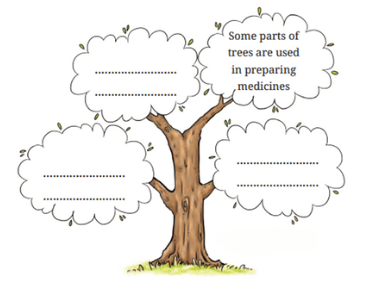
Answer:
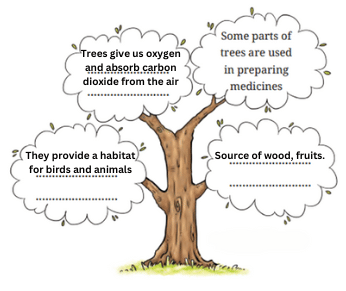
2. Neem is a common tree in our country. Discuss in groups of four and fill Columns A and B with what you know about the neem tree and what you want to know.
Answer:
| Column A What you know | Column B What you want to know |
| Neem trees are used in medicines | What is the best way to plant and care for a neem tree to help it thrive? |
| Neem oil is used to make soaps and toothpaste | What specific chemicals in neem make it effective against germs and insects? |
| Neem seed powder is a powerful pesticide powerful pesticide | Are there any festivals or rituals in India that involve the use of neem leaves or branches? |
| Neem leaves protect clothes and food from insects | Can neem products be used for pets or animals as well? |
Let us discuss (Page 77)
Amber found many facts about the neem tree from Neem Baba. Fill up the fact sheet based on what Neem Baba told her.
Answer:
| Let Us Know Our Neem | ||
| Common name | Neem | Given by: Iranians |
| Period of birth | Millions of years ago | |
| Born at | North India and Myanmar | |
| Found in | Asia, Africa, some parts of America | |
| Common names | Arishta “the one who cures diseases”, Nimba, Nimbaca | Sanskrit names |
| Nimb | Hindi name | |
| Nim, Leemba, Nimori, Nimbamond, Nimbe and Nimo | Other names in India | |
| Names given by scientists | “Bitter grace of God,” | |
| “Nature’s gift to man” | ||
| “Cleanliness-parting Tree” | ||
| Names given by others | “Magic tree,” | |
| “Tree of the twentieth century” | ||
Let us discuss (Page 80)
1. How is neem useful to farmers?
Answer:
Neem is useful to farmers because neem seed powder mixed in water is sprayed on plants and crops to protect them from locusts, termites, and other insects. It also helps prevent mosquito and other insects from breeding in rice fields, increases crop yield, and keeps the soil fertile.
2. Mention some of the uses of the neem tree.
Answer:
Some uses of the neem tree are:
Neem leaves are used in medicines and to protect clothes.
Neem twigs are used to clean teeth.
Neem oil is used in soaps and toothpaste.
Neem seed powder is added to stored grains to protect them from insects.
Neem trees purify the air
Termite resistant furniture is made from neem trees
Let us think and reflect (Page 81)
1. You just read about the Neem tree. Write any two facts that surprised you the most.
Answer:
Two facts which surprised me the most are:
· Neem can purify air and is called the “tree of the twentieth century.”
· Neem seed powder can prevent mosquitoes from breeding and protect crops.
2. Complete the following sentences.
(a) The old man asked Amber to call him Neem Baba because he was old and had known her since her childhood.
(b) Neem seed powder protects crops from locusts, termites, mosquitoes and other insects.
(c) Adding neem seed powder to stagnant water is a cost-effective method to stop mosquitoes from breeding in stagnant water.
(d) One reason why doctors advise us to use neem leaves for someone suffering from measles is that neem’s chemical properties help prevent germs from breeding and soothe itching.
3. Why can Neem Baba not remember the year when he was born?
Answer:
Neem Baba cannot remember the year when he was born because millions of years have passed since his birth.
4. Which parts of the neem tree are used to make medicines?
Answer:
Neem leaves, bark, flowers, fruits, and roots are all used to make medicines.
Let us learn (Page 81)
1. Study these words from the text.
something
neem oil
cleanliness-parting
well known
grandmother
seed powder
childhood
well trained
thought-provoking
Put the compound words given above in their trees.
These words are known as compound words. There are three types of compound words, based on how the words are separated.
Open compound words: spaces between the words.
Closed compound words: no spaces between the words.
Hyphenated compound words: hyphens between the words.
You may add some more words:
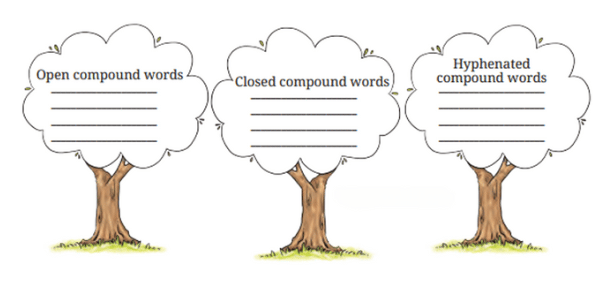
Answer:
Add a few more words to each category:
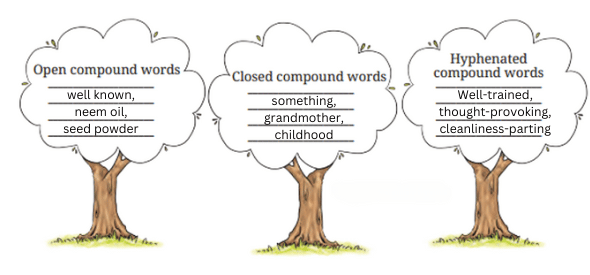
2. Words that tell us what a person is doing are called verbs. In the table given below, match the verbs in the first column showing action in the present to verbs in the second column showing action in the past. Make a sentence with any one form of the verb. One has been done for you.
| Present | Past | Answer | Sentence |
| 1. become | a. made | 1.d | I want to become a teacher when I grow up. |
| 2. find | b. gave | ||
| 3. make | c. told | ||
| 4. discover | d. became | ||
| 5. tell | e. found | ||
| 6. give | f. discovered |
Answer:
| Present | Past | Answer | Sentence |
| 1. become | a. made | 1.d | I want to become a teacher when I grow up. |
| 2. find | b. gave | 2.e | Rani found a home for the stray puppy. |
| 3. make | c. told | 3.a | Mother makes the best chicken biryani. |
| 4. discover | d. became | 4.f | Scientists discovered a new source of water. |
| 5. tell | e. found | 5.c | The teacher told them to stay back for extra classes. |
| 6. give | f. discovered | 6.b | The school athlete gave his best but could not win the trophy. |
3. Neem Baba speaks to Amber as if he is a person. This figure of speech is called personification. Let us look at some more examples.
• The leaves whispered in the wind.
• The flowers danced merrily in the breeze.
Now, discuss it with your classmates and teacher.
Answer:
Personification is a literary device which gives life-like qualities to natural elements, inanimate objects, or abstract ideas making us feel as if they have emotions, intentions, or personalities.
For example, saying, “the leaves whispered” makes us feel like the tree is talking intimately to Amber, sharing a secret just like a friend would.
When we read “the flowers danced merrily” we visualise a dynamic picture of movement, rhythm, and playfulness. We see the flowers swaying merrily in the breeze just as if they were little dancing girls.
Attributing human qualities to nature can make descriptions more engaging and help us feel a stronger connection to the environment.
In the story, when Neem Baba speaks to Amber, a special bond begins to grow between them, almost like a family bond. Neem Baba, with his gentle wisdom, shares stories about his ancient roots and how his family spread across the world—from North India and Myanmar to faraway places in Asia, Africa, and even America.
Through these stories, Amber starts to see Neem Baba not just as a tree, but as a wise elder with a rich history, caring for people by giving medicine, protecting crops, and even keeping mosquitoes away.
This way of writing, called personification, brings stories and poems to life, filling them with personality and making the ideas stick in our minds. It helps us connect with nature and understand its importance, making stories more enjoyable and interesting.
Listening Comprehension (Page 83)
Let us listen
You will now listen to a boy speaking to his mother. As you listen, select the correct statements. (refer to page 101 for transcript)
(a) The mother was surprised to know that Peepal Baba had planted trees all over the country.
(b) The mother disliked the work being done by Peepal Baba.
(c) The mother wanted to know more about Peepal Baba.
(d) The boy decided to take care of trees by listening to Peepal Baba’s journey.
(e) The boy was worried about what his teacher had told him.
Answer:
From the above conversation, the correct statements are:
The mother was surprised to know that Peepal Baba had planted trees all over the country.
The mother wanted to know more about Peepal Baba.
Rahul decided to take care of trees after hearing about Peepal Baba’s journey.
Let us speak (Page 83)
Collect dry leaves of four different trees and plants around you.
1. Make one card as given below. On the top, draw the shape of the leaf looking at the dry leaf and colour it. Inside the card, write the name of the tree/plant the leaf is taken from and one of its uses.
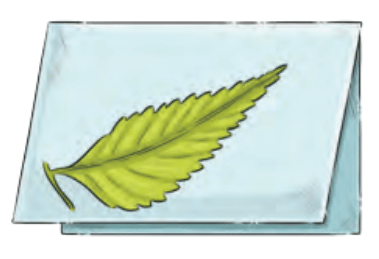
Answer:
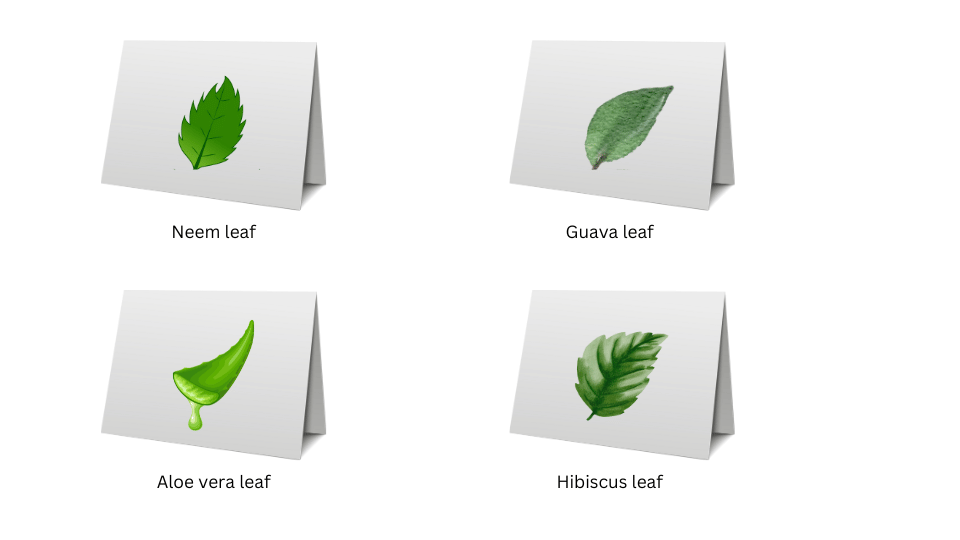
Neem Leaf: Used as a natural remedy for skin infections due to its antibacterial properties.
Guava leaf: Beneficial for gum health! Guava leaf extract has natural antibacterial, anti-inflammatory, and antimicrobial properties that can help reduce gum inflammation
Aloe vera: The gel inside is used to soothe skin irritations, burns, and can even be applied as a moisturizer.
Hibiscus: Used in hair care, as it helps condition the scalp and prevent dandruff.
2. Now, speak about the whole process of making the card in front of the class.
Answer:
Good morning, everyone!
Today, I’m happy to share my experiences and revelations while doing my leaf collection project with you. I went outside and collected four different kinds of dry leaves from trees and plants around my neighbourhood. It was really interesting because I realized how each leaf has its own unique shape, size, and even texture. I chose leaves four different leaves which have special uses, but will not reveal their names now because I want to see whether you are able to guess the names of the leaves I have collected.
After collecting the leaves, I made a card for each one. At the top of each card, I drew the shape of the leaf, trying to copy it as closely as I could. Then I coloured them to make them look like the real leaves I found. Inside each card, I wrote down the name of the tree or plant and one useful thing about each leaf. For example, the neem leaf is used in herbal medicine,
Now, let’s see if you can recognise these leaves! I’ll show you a card, and you can guess what kind of leaf it is and what it might be used for. After you guess, I’ll open the card and reveal what I wrote.
Thank you for listening, and I hope you enjoy learning about these amazing leaves as much as I did!
3. Ask your classmates to identify the leaf and tell them one of its uses. After they answer, open the card, and share what you have written.
Answer:
You may ask four of your classmates to pick one card each with their eyes closed.
Once they have picked a card, ask them to identify the leaf and mention one of its uses.
After they answer you can read out the details you have written.
Let us write (Page 84)
You have read about Neem Baba and learnt many things about the neem tree. Look at the trees in your neighbourhood and write a paragraph about any one tree that you like.
• Where it is (roadside / park, etc.)
• How it looks (height, tree trunk, leaves, flowers, etc.)
• Why you like it (shade, medicinal properties, shelter, beauty, etc.)
• Give a title to your paragraph.
Answer:
The Generous Jackfruit Tree
On the pavement in front of my building stands a sturdy jackfruit tree. This tree has a strong, rough trunk and about 35 feet tall. Its broad, dark green glossy oval leaves have a leathery feel. They form a dense canopy, which casts a cool shade below. The street dogs curl up in the shade on hot summer afternoons. The jackfruit tree is truly remarkable because its fruit not only hangs from its branches but also grows closer to the ground, even sprouting from its lower trunk and roots. This unique feature allows animals to enjoy the nutritious fruit as well as he birds. The fruit is large, has a spiky skin and a strong odour which some people find irresistible while others find intolerable. It contains bulbous fleshy segments that are very sweet and juicy. I admire this tree for its generous nature, as it provides food and shelter to people and animals alike, making it a true friend of nature.
Let us explore (Page 84)
When people from Persia came to India and saw that a common tree of their country was freely growing here, they started calling the tree Azad Darakhte Hindi. So, the scientific name of Neem in Latin became Azadirachta indica.
Neem has different names in the Indian languages. Discuss with your teacher and find out which Indian languages these names belong to.
| Name | Nimb | Nim | Leemba | Nimori | Nimbamond | Nimbe | Nimo |
| Indian | Hindi | Bengali | Marathi | Gujrati | Telegu | Kannada | Assamese |
Frequently Asked Questions (FAQs) on NCERT Class 6 English Poorvi Unit 3 Nurturing Nature Chapter 7 ‘Neem Baba’
We have seasoned English experts on staff who have taken care to explain the lesson to you in a lucid and easy-to understand manner. Solutions to all end text questions and in-text activities have been provided which cover the story in detail and help you focus on the important aspects.
You can also download the free PDFs of the solutions anytime you please! We will keep providing you with plenty of top-quality study material and resources to help you prepare. So, make sure you keep visiting our website and join our email list to take advantage of them! (insert hyperlink)
Yes indeed! You can download the free PDF versions of these excellent solutions anytime (please look towards the top of the page)!.
Our experienced English faculty have crafted these solutions which guide you to notice every detail of the lesson. We advise you to go through the text at first and look up the meanings of words that you might not know. This step must not be skipped as it will not only help you to understand the lesson better, but also enrich your vocabulary to a great extent.
Then you need to go through all the answers we have thoughtfully provided – both to the questions at the back of the lesson as well as the in-text questions and activities in order to grasp the essence of story. Pay close attention to details. Do not memorise because understanding the text is the key to learning.
Subsequently, you need to practise writing down the answers within a specific time frame. You can then ace your exams! There is no short cut to success! Systematic study will help you achieve what you want.
Feeling lost or anxious about your studies and future? We understand how overwhelming it can be to face these challenges alone. But don’t worry, you’re not alone—we’re here to help.
At educationroundtheworld.com, we connect you with dedicated teacher-mentors who are passionate about guiding students like you toward success by offering the support you need to achieve your goals.
Book your first session with us to begin the process of creating a customized study plan that suits your unique needs and aspirations. Together, we’ll focus on building your confidence and skills so you can move forward with a clear, actionable plan for success.
Say goodbye to the stress and uncertainty—let’s work together to pave the way for your bright future, starting today!
Take the first step now—reach out to us and unlock your full potential!


